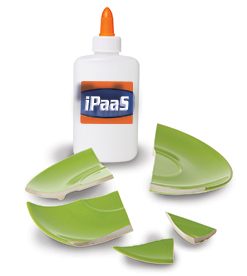
Adoption of integration platform-as-a-service solutions for combining disparate services into a cohesive application has seen a steady but slowing growth among businesses.
Gartner Research found in its “Magic Quadrant for Enterprise Integration Platform as a Service” report that more than 50,000 companies globally have implemented some form of iPaaS as of 2017. And, Gartner writes, “By 2021, enterprise iPaaS will be the largest market segment in application integration middleware, potentially consuming the traditional software delivery model along the way.” This can be attributed to a growing need to more easily manage and maintain hybrid portfolios of on-premise and multi-cloud application environments, Gartner said.
“Fewer organizations with existing integration skills are finding that their established on-premises integration practices can be used to integrate with multi-cloud applications,” Gartner wrote in its report. “Most organizations find that their existing approaches are just not delivering fast enough to meet the new challenges. For organizations that never established integration practices on-premises, the thought of having to start now is daunting. The large costs, lack of available skills, long delivery times and complex infrastructure builds associated with traditional on-premises approaches are just not in line with today’s lean approaches and timelines.”
Besides the benefit of broad-reaching and environment-neutral integration, iPaaS implementation can have a more abstract benefit outside of simply streamlining how internal systems communicate and evolve. Forrester Research says that with a properly managed network of integrated systems, businesses can more easily predict trends and rapidly reconfigure their integrations to keep up with what their customers value most in an application service.
Henry Peyret, a principal analyst at Forrester, led the firm’s “Now Tech: iPaaS And Hybrid Integration Platforms, Q3 2018” report, and explained how customer dissatisfaction with one aspect of a product portfolio can lead them elsewhere.
“While thinking about continuously trying to deliver more value to customers, those values will evolve, provoking a change in the business — to completely changing to what we are calling the ‘dynamic ecosystem of values,’” Peyret said. “The customers are constantly looking to get more value for themselves, and they will look for different brands amongst products, and when the enterprise is not supplying the piece of value the customers are looking for, those customers will go to some different supplier to provide them that additional value.” For example, Peyret said, a company supplying power isn’t going to help a business cut power costs, as their values don’t align, leading the business to look to other places to lower power consumption.
The construction of this value-aligned relationship begins with conceptualizing the relationship between the end-user and application service provider not as the linear motion from vendor to retailer to customer, Peyret said, but rather as a two congruent ecosystems — that of the users’ expectations and values, and that of the business’s systems and adaptation to meet those values — interconnected by a mesh of suppliers, retailers and digital services.
Forrester breaks down the application provider’s systems, or the components that an iPaaS solution primarily integrates, into systems of design, or the broader way a business is planned and developed; systems of engagement, which are concerned with direct customer experiences and feedback; systems of operation, which includes automation and overall application operation; and systems of record, which collect and manage data — their integration culminating in a system of insight made up of dynamic integration features and Data Lake architecture.
“The previous integration, when we were only integrating systems of record, we were using batch file transfer and that sort of thing to do integration, and it was very static because the systems of record were changing maybe only every 10 years, driven by a gain or an SAP,” Peyret said. “Now that we have to integrate the system of record with the system of engagement, where systems of engagement are continuously changing, perhaps every week or month, we need to get more flexibility. That’s what I describe with ‘dynamic integration’ and the tooling to support that dynamic integration and provide some elasticity between systems which are getting very different lifecycles in the IPaaS category.”
Peyret elaborated on how each system comes with its own life cycle, or time between iteration or significant change.
“There is a big difference in terms of the life cycle of each of those systems,” Peyret said. “With system of record, the life cycle is driven by software companies. While at the same time, system of engagement is driven more by those customers who want to engage differently — they want to engage first on the web, then move to phone and when the phone’s not working, they want to chat on mobile and then perhaps the customer gets a chatbot. So that’s the sort of evolution of system of engagement, which is getting your life cycle so that it is driven to answer that continuous research of value for customers. The same also for system of design, where it’s different for different products. If you’re building planes, your system of design should support planes, refurbishing and maintaining for probably 50 years so that your system of design really lasts for 50 years. When you start to integrate those different systems, we start to see big changes in integration.”
But the world of iPaaS isn’t so plug-and-play that every option is right for every business. Both Gartner and Forrester noted that there is a growing space for iPaaS solutions aimed at mid-sized businesses, while large-scaled solutions tailored for enterprise customers (EiPaaS) are fairly developed.
“During 2017, we noticed a clear split in the iPaaS market,” Gartner wrote in its report. “The larger vendors shifted to what has become EiPaaS, for more strategic adoption and a broader set of use cases. There was also huge growth in the number of domain-specific vendors, with a much narrower go-to-market strategy focused on domains such as B2B, education, accounting and others.”
Forrester’s Peyret says this comes down to the difficulty for an iPaaS company to provide a managed service of sufficient quality at the price-point and scale that characterizes mid-size business operations. Forrester breaks iPaaS down into the categories of:
- iPaaS for dynamic integration, aimed at small and mid-sized organizations just beginning to develop a cloud strategy and adoption of integration technologies, often including templates and no-code, visual development and administration wizards
- strategic iPaaS (SiPaaS), a more complex category which “includes some B2B integration, IoT integration, and connectors to on-premises applications,” and which is “essentially cloud-based;”
- hybrid integration platforms (HIT), which Forrester calls “mandatory” for large enterprise customers with API management, B2B and IoT integrations and come in “bundles” of multiple products that run on-premises, in the cloud and in hybrid infrastructure.
“IPaas is mainly a more technical product, and mainly made to support the midsize market, which is discovering the separation the system of record and system of engagement,” Peyret said. “And as they want to deal with some very simple integration capabilities, they are dealing with the customer iPaaS category. [These offerings] are simpler, so [those customers] are getting the pricing that is more in-line with the mid-size market, costing $2,000 to $20,000 in subscription costs per year. But there is no guarantee, with that pricing, of the quality of service or about SLA, but that’s enough, in fact, for most of the mid-sized businesses. Then some of the mid- to large-sized companies which are adopting a broad category of hybrid integration platforms are also dealing with the problem of agility and of dynamic integration. In that case, they are choosing either to replace, or to complement, the hybrid integration platform with what we are calling strategic iPaaS, where pricing is closer to $20,000 to $70,000 per year. And they are also more powerful and they are more complex, so it is more difficult to operate by a small IT team.”
Forrester’s report found that the growth of the types of products that are easier to use and aimed at the mid-sized market will increase, in some small way, the role of the citizen integrator, or employees within an organization who aren’t dedicated to integration technologies, but whose knowledge of the business and of the customers’ needs can be put to use in setting up integrations in no/low-code visual environments. But Peyret was very clear with his judgment that iPaaS technology, and broad knowledge of the technology, is not to the point where companies can skimp on dedicated integrators just yet.
“Even if some citizen integrator can do some of the job, I don’t recommend to let those citizen integrators do everything,” Peyret said. “There is always some risk in providing that sort of integration — it requires governance. And putting someone in charge is really the right approach, along with those citizen integrators. If you are really getting some people with low knowledge about what integration is, the different consequences, the different risks, we should also get the right level of governance.”
Though Peyret says that too much governance can lead to the static, unresponsive type of integration that failed before iPaaS and is a hindrance towards cultivating that ‘dynamic ecosystem of values,’ which he says will help retain customers and ultimately be a boon to everyone enmeshed in the ecosystem.
“When companies are organizing and aligning with their customers and always providing more value for their customers, they are also getting value to their employees, to their shareholders, to their partners and also regulators as well,” Peyret said.





